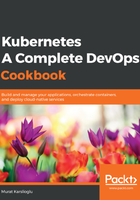
上QQ阅读APP看书,第一时间看更新
Setting log levels
When using the kubectl command, you can set the output verbosity with the --v flag, followed by an integer for the log level, which is a number between 0 and 9. The general Kubernetes logging conventions and the associated log levels are described in the Kubernetes documentation at https://kubernetes.io/docs/reference/kubectl/cheatsheet/#kubectl-output-verbosity-and-debugging.
It is useful to get the output details in a specific format by adding one of the following parameters to your command:
- -o=wide is used to get additional information on a resource. An example is as follows:
$ kubectl get nodes -owide
NAME STATUS ROLES AGE VERSION INTERNAL-IP EXTERNAL-IP OS-IMAGE KERNEL-VERSION CONTAINER-RUNTIME
ip-192-168-41-120.us-west-2.compute.internal Ready <none> 84m v1.13.8-eks-cd3eb0 192.168.41.120 34.210.108.135 Amazon Linux 2 4.14.133-113.112.amzn2.x86_64 docker://18.6.1
ip-192-168-6-128.us-west-2.compute.internal Ready <none> 84m v1.13.8-eks-cd3eb0 192.168.6.128 18.236.119.52 Amazon Linux 2 4.14.133-113.112.amzn2.x86_64 docker://18.6.1
- -o=yaml is used to return the output in YAML format. An example is as follows:
$ kubectl get pod nginx-deployment-5c689d88bb-qtvsx -oyaml
apiVersion: v1
kind: Pod
metadata:
annotations:
kubernetes.io/limit-ranger: 'LimitRanger plugin set: cpu request for container
nginx'
creationTimestamp: 2019-09-25T04:54:20Z
generateName: nginx-deployment-5c689d88bb-
labels:
app: nginx
pod-template-hash: 5c689d88bb
name: nginx-deployment-5c689d88bb-qtvsx
namespace: default
...
As you can see, the output of the -o=yaml parameter can be used to create a manifest file out of an existing resource as well.